|
|
 |
Fiche d'espèce de Copépode |
|
|
Calanoida ( Ordre ) |
|
|
|
Clausocalanoidea ( Superfamille ) |
|
|
|
Clausocalanidae ( Famille ) |
|
|
|
Drepanopus ( Genre ) |
|
|
| |
Drepanopus forcipatus Giesbrecht, 1888 (F,M) | |
| | | | | | | Syn.: | Drepanopus pectinatus : Giesbrecht, 1892 (p.201, figs.F,M:); T. Scott, 1914 (p.8, figs.F,M); Hardy & Gunther, 1935 (p.156, Rem., distribution charts); Ramirez, 1966 (p.11, figs.F); Pallares, 1968 b (p.27, figs.F,M); Arcos, 1975 (Pl.3, figs.F,M) | | | | Ref.: | | | Sewell, 1948 (p.402, 450, 573); Vervoort, 1957 (p.40); Fagetti, 1962 (p.16); Ramirez, 1969 (p.55, figs.M, Rem.); Arcos, 1975 (p.13, figs.F,M. Indicated by error as D. pectinatus ); Björnberg & al., 1981 (p.628, figs.F, M); Bayly, 1982 (p.165, Rem.); Hulsemann, 1985 a ( Rev., p.909, figs.F,M, Rem.); 1991 a (p.107, figs. Juv.,M); 1991 b (p.199, figs. juv.:1-5, F,M); Razouls, 1994 (p.56, figs.F,M); Mazzocchi & al., 1995 (p.166, figs.F,M, Rem.); Bradford-Grieve & al., 1999 (p.878, 915, figs.F,M); Bucklin & al., 2003 (p.335, tab.2, figs.1, 4, Biomol); Park & Ferrari, 2009 (p.143, Table 1, Appendix 1, biogeography from Southern Ocean); Xavier & al., 2020 (p.21, fig., Rem.). | 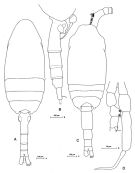 Issued from: M.G. Mazzocchi, G. Zagami, A. Ianora, L. Guglielmo & J. Hure in Atlas of Marine Zooplankton Straits of Magellan. Copepods. L. Guglielmo & A. Ianora (Eds.), 1995. [p.167, Fig.3.29.1]. Female: A, habitus (dorsal); B, urosome (lateral right side). Nota: Proportional lengths of urosomites and furca 41:19:13:11:16 = 100. P5 with bulbous base, terminal spine bent distally and ornated with 30 or more small teeth. Male: C, habitus (dorsal); D, P5. Nota: Proportional lengths of urosomites and furca 9:37:18:14:10:12 = 100. A1 with 3 conspicuous patches of long spinules at base. A2 with a row of curved spines at the base of its inner side. Left P5 bears 2 distinct patches of spines on the inner margin of the exopod 1.
|
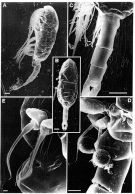 Issued from: M.G. Mazzocchi, G. Zagami, A. Ianora, L. Guglielmo & J. Hure in Atlas of Marine Zooplankton Straits of Magellan. Copepods. L. Guglielmo & A. Ianora (Eds.), 1995. [p.168, Fig.3.29.2]. Female (SEM preparation): A, habitus (lateral left side); B, idem (dorsal); C, urosome (dorsal); D, eggs being spawned from the genital aperture; E, P5. Bars: A, B, C 0.100 mm; D 0.050 mm; E 0.010 mm.
|
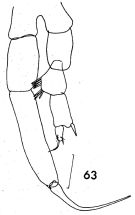 issued from : F.C. Ramirez in Contr. Inst. Biol. mar., Buenos Aires, 1969, 98. [p.56, Lam. IX, fig.63 ]. Male (from off Mar del Plata): 63, P5. Scale bar in mm: 0.05.
|
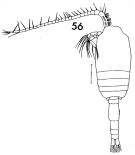 issued from : F.C. Ramirez in Contr. Inst. Biol. mar., Buenos Aires, 1969, 98. [p.50, Lam. VIII, fig.56 ]. Male (from off Mar del Plata): 56, habitus (dorsal). Scale bar in mm: 0.1.
|
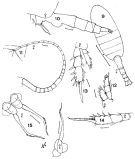 issued from : F.C. Ramirez in Bol. Inst. Biol. Mar., Mar del Plata, 1966, 11. [Lam.II, Figs.9-16] As Drepanopus pectinatus. Female (from off Mar del Plata): 9, habitus (dorsal); 10, posterior part cephalothorax with P5 and urosome (lateral left side); 11, A1; 12, P1; 13, P2; 14, exopod of P3; 15, P5; 16, P5 (side-face).
|
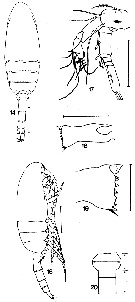 issued from : K. Hulsemann in J. Plankton Res., 1985, 7 (6). [p.915, Figs.14, 16-19]. Female: 14, 16, habitus (dorsal and lateral, respectively); 17, right A2; 18, right Md (mandible blade); 19, md (bitting edge, enlarged). Scale bars: 0.5 mm (Figs. 14, 16); 0.2 mm (Figs.17, 18); 0.1 mm (Fig.19).
|
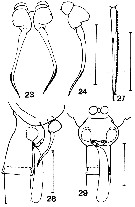 issued from : K. Hulsemann in J. Plankton Res., 1985, 7 (6). [p.918, Figs.23, 24, 27-29]. Female: 23, P5 (ventral view); 24, right P5 (lateral view); 27, terminal spine of left P2; 28, genital segment with spermatophore (lateral); 29, idem (ventral). Scale bars: 0.2 mm (Figs.23, 24, 28, 29); 0.1 mm (Fig.27).
|
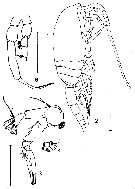 issued from : K. Hulsemann in J. Plankton Res., 1985, 7 (6). [p.912, Figs.2-4, 6]. Male: 2, habitus (lateral); 3, right A2; 4, right A2 (enlarggement of basis); 6, P5 (anterior view). Scale bars: 0.5 mm (Fig.2); 0.2 mm (Figs.3, 6).
|
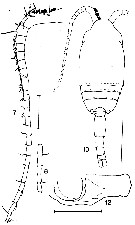 issued from : K. Hulsemann in J. Plankton Res., 1985, 7 (6). [p.914, Figs.7, 8, 10, 12]. Male: 7, right A1; 8, left A1 (segments 18-22); 10, habitus (dorsal); 12, right Md (mandible blade). Scale bars: 0.5 mm (Fig10); 0.2 mm (Figs.7, 8); 0.1 mm (Fig.12).
|
 issued from : K. Hulsemann in J. Plankton Res., 1985, 7 (6). [p.916, Table III]. Total length and prosome:urosome length ratio in adult females. n = 30 individuals. sta. WS 42: 54°42'S, 36°47'W; sta. WH 301: 54°48'S, 35°37'W.
|
 issued from : K. Hulsemann in J. Plankton Res., 1985, 7 (6). [p.917, Table V]. Various ratios between selected dimensions in genital segment of adult females. n = 30 individuals.
|
 issued from : K. Hulsemann in J. Plankton Res., 1985, 7 (6). [p.913, Table I]. Total length and prosome:urosome length ratio in adult males. n = 30 individuals.
|
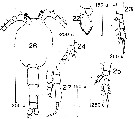 issued from : D.F.R. Arcos in Gayana, Zool., 1975, 32. [Lam.III, Figs.22-27]. As Drepanopus pectinatus. Female (from Bahia de Concepcion, Chile): 22, P5; 23, P4; 24, P3; 25, P2. Male: 26, forehead (dorsal); 27, P5.
|
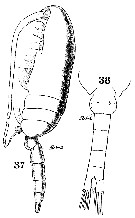 Issued from : W. Giesbrecht in Systematik und Faunistik der Pelagischen Copepoden des Golfes von Neapel und der angrenzenden Meeres-Abschnitte. – Fauna Flora Golf. Neapel, 1892, 19 , Atlas von 54 Tafeln. [Taf. 36, Figs.37, 38]. As Drepanopus pectinatus. Female: 37, habitus (lateral); 38, urosome (ventral).
|
 Issued from : W. Giesbrecht in Systematik und Faunistik der Pelagischen Copepoden des Golfes von Neapel und der angrenzenden Meeres-Abschnitte. – Fauna Flora Golf. Neapel, 1892, 19 , Atlas von 54 Tafeln. [Taf. 10, Fig.27]. As Drepanopus pectinatus. Female: 27, P1 (anterior surface).
|
 Issued from : W. Giesbrecht in Systematik und Faunistik der Pelagischen Copepoden des Golfes von Neapel und der angrenzenden Meeres-Abschnitte. – Fauna Flora Golf. Neapel, 1892, 19 , Atlas von 54 Tafeln. [Taf. 10, Fig.28]. As Drepanopus pectinatusFemale: 23, A2 (anterior view); 24, Md; 25, Mx1 (posterior view)
|
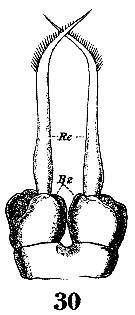 Issued from : W. Giesbrecht in Systematik und Faunistik der Pelagischen Copepoden des Golfes von Neapel und der angrenzenden Meeres-Abschnitte. – Fauna Flora Golf. Neapel, 1892, 19 , Atlas von 54 Tafeln. [Taf. 10, Fig.30]. As Drepanopus pectinatus. Female: 30, P5 (posterior surface).
|
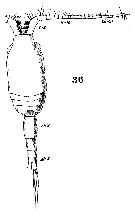 Issued from : W. Giesbrecht in Systematik und Faunistik der Pelagischen Copepoden des Golfes von Neapel und der angrenzenden Meeres-Abschnitte. – Fauna Flora Golf. Neapel, 1892, 19 , Atlas von 54 Tafeln. [Taf. 36, Fig.36]. As Drepanopus pectinatus. Male:
|
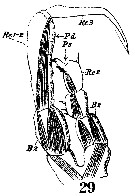 Issued from : W. Giesbrecht in Systematik und Faunistik der Pelagischen Copepoden des Golfes von Neapel und der angrenzenden Meeres-Abschnitte. – Fauna Flora Golf. Neapel, 1892, 19 , Atlas von 54 Tafeln. [Taf. 10, Fig.29]. As Drepanopus pectinatus. Male: 29, P5 (posterior view).
|
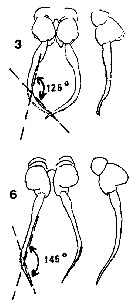 issued from : C. Razouls in Ann. Inst. Océanogr., 1994, NS. 70 (1). [p.57, Pl. 20]. P5 female comparison between D. pectinatus (3), and D. forcipatus (6).
| | | | | Ref. compl.: | | | C.B. Wilson, 1950 (p.200); Björnberg, 1973 (p.317, 385, carte); Arcos, 1976 (p.85, Rem.: p.91, Table II); Schnack & al., 1985 (p.256, fig.4); Dearborn & al., 1986 (p.1, predation by benthic star); Ferrari & Dearborn, 1989 (p.1315, predator); Ward, 1989 (p.141, distribution, tab.2); North & Ward, 1990 (p.299, predation by larval fish); Atkinson & al., 1990 (tab.1); Santos & Ramirez, 1991 (p.79, 80, 82, 83); Øresland & Ward, 1993 (p.73, Rem.: p.77, predation by Euchaeta); Atkinson, 1994 (p.551, feeding selectivity); Fernandez Araoz, 1991 (p.575); Santos & Ramirez, 1995 (p.133, Tabl. I, fig.2, 3); Ward & al., 1995 (p.195, abundance, biomass, vertical distribution); Razouls & al., 2000 (p.343, tab. 3, Appendix); Cripps & Atkinson, 2000 (p.31, Rem: Fatty acid); Sabatini & al., 2001 (p.245, figs.6, 7, 8); Ward & al., 2002 (p.2183, tab.2); Marrari & al., 2004 (p.667, tab.1); Berasategui & al., 2005 (p.485, tab.1); Berasategui & al., 2006 (p.485: fig.2); Ward & al., 2006 (p.83: tab.4); Biancalana & al., 2007 (p.83, Tab.2, 3); Ward & al., 2007 (p.1871, Table 2, fig.6, abundance); Ward & al., 2008 (p.241, Tabls, Appendix II ); Sabatini, 2008 (p.981, life history); Muelbert & al., 2008 (p.1662, Table 1); C.E. Morales & al., 2010 (p.158, Table 1); Hidalgo & al., 2010 (p.2089, fig.2, 4, Table 2, cluster analysis); Antacli & al., 2010 (p.71, Table 1, 2, Figs.3, 6); Guglielmo & al., 2012 (p.1301, Table 3); Ward & al., 2012 (p.78, Table B1, abundance); Sabatini & al., 2012 (p. 33, Table 3, abundance vs stations transect); Spinelli & al., 2012 (p.39, potential prey for fish); Aguirre & al., 2012 (p.341, Table I: abundance vs season, figs.4, 7); Hidalgo & al., 2012 (p.134, Table 2, 3, figs.6, 8, occurrence vs hydrology); Pino-Pinuer & al., 2014 (p.83, Table 1, fig.3, 4, abundance variation vs time); Fierro Gonzalvez, 2014 (p.1, Tab. 3, 4, 5, occurrence, abundance); Antacli & al., 2014 (p.17, occurrence vs community structure); Antacli & al., 2018 (p.295, feeding, reproduction); Acha & al., 2020 (p.1, Table 3: occurrence % vs ecoregions, Table 5: indicator ecoregions). | | | | NZ: | 4 | | |
|
Carte de distribution de Drepanopus forcipatus par zones géographiques
|
| | | | | |  Carte de 1996 Carte de 1996 | |
 issued from : K. Hulsemann in J. Plankton Res., 1985, 7 (6). [p.921, table VII]. issued from : K. Hulsemann in J. Plankton Res., 1985, 7 (6). [p.921, table VII].
Distributional records of D. forcipatus (1985). |
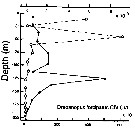 Issued from : P. Ward, A. Atkinson, A.W.A. Murray, A.G. Wood, R. Williams & S. Poulet in Polar Biol., 1995, 15. [p.200, Fig.3]. Issued from : P. Ward, A. Atkinson, A.W.A. Murray, A.G. Wood, R. Williams & S. Poulet in Polar Biol., 1995, 15. [p.200, Fig.3].
Abundance and biomass (g dry mass/m3) profiles for the shelf station (54°48'S, 38°15'W) in January 1990.
Values on the horizontal axes at the base represent abundance and the one above biomass. Solid line = midday haul; hatched line = midnight haul. |
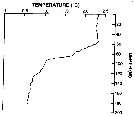 Issued from : P. Ward, A. Atkinson, A.W.A. Murray, A.G. Wood, R. Williams & S. Poulet in Polar Biol., 1995, 15. [p.198, Fig.1, A (modified C.R.)]. Issued from : P. Ward, A. Atkinson, A.W.A. Murray, A.G. Wood, R. Williams & S. Poulet in Polar Biol., 1995, 15. [p.198, Fig.1, A (modified C.R.)].
Temperature profile for the shelf station at Bird Island, South Georgia (54°48'S, 38°15'W) in January 1990. |
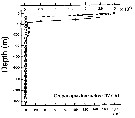 Issued from : P. Ward, A. Atkinson, A.W.A. Murray, A.G. Wood, R. Williams & S. Poulet in Polar Biol., 1995, 15. [p.202, Fig.4, A]. Issued from : P. Ward, A. Atkinson, A.W.A. Murray, A.G. Wood, R. Williams & S. Poulet in Polar Biol., 1995, 15. [p.202, Fig.4, A].
Abundance (10/m3) and biomass (g dry mass/m3) profiles at the oceanic station from the shelf break in water 4000 m deep off Bird Island, South Georgia (53°04'S, 39°51'W) in January 1990.
Values on the horizontal axes at the base of each profile represent abundance and the one above biomass. Solid line = midday haul; hatched line = midnight haul. |
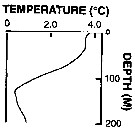 Issued from : P. Ward, A. Atkinson, A.W.A. Murray, A.G. Wood, R. Williams & S. Poulet in Polar Biol., 1995, 15. [p.198, Fig.1, B (modified C.R.)]. Issued from : P. Ward, A. Atkinson, A.W.A. Murray, A.G. Wood, R. Williams & S. Poulet in Polar Biol., 1995, 15. [p.198, Fig.1, B (modified C.R.)].
Profile temperature-depth at the oceanic stations from the shelf break in water 4000 m deep off Bird Island, South Georgia, in January 1990. |
 Issued from : G.A. Aguirre, F.L. Capitanio, G.A. Lovrich & G.B. Esnal in Mar. Biol. Res., 2012, 8. [p.349, Fig. 7 E, F]. Issued from : G.A. Aguirre, F.L. Capitanio, G.A. Lovrich & G.B. Esnal in Mar. Biol. Res., 2012, 8. [p.349, Fig. 7 E, F].
Abundance (ind/m3) distribution of Drepanopus forcipatus during March 2006 and June 2006 in the Beagle Channel.
In this area the surface water temperature ranges from 4.2-4.3°C in August to 8.9-9.8°C in Juanary, while the salinity ranges from 26.7 psu in November-December to 31.3 psu during July.
According to Klöser (1996) the Channel between the Isla Navarino and the Isla Grande de Tierra del Fuego has the character of a semi- enclosed water body. |
| | | | Loc: | | | Antarct. (N Peninsula, Scotia Sea, South Georgia), Beagle Channel, Magallones region, sub-Antarct. (S South America, Falklands, N South Georgia, Chile (S, Concepcion off Santiago), Ushuaia, Magellan Strait ), Patagonian Shelf, Peninsula Valdés, off Mar del Plata, off Cape San Antonio, Uruguay (continental shelf) | | | | N: | 53 | | | | Lg.: | | | (36) F: 1,78-1,39; M: 1,35-1,12; (47) F: 1,9-1,5; M: 1,48-1,22; (115) F: 2,74-1,84; M: 1,94-1,66; (202) F: 1,5-1,9; M: 1,22-1,49; (861) F: 1,79-1,84; M: 1,46-1,48; {F: 1,39-2,74; M: 1,12-1,94} | | | | Rem.: | Néritique, littorale.
Sampling depth (Antarct., sub-Antarct.) : 0-250 m.
La courbure de la P5 permet de distinguer aisément cette espèce de D. pectinatus.
Voir aussi les remarques en anglais | | | Dernière mise à jour : 14/06/2022 | |
|
|
 Toute utilisation de ce site pour une publication sera mentionnée avec la référence suivante : Toute utilisation de ce site pour une publication sera mentionnée avec la référence suivante :
Razouls C., Desreumaux N., Kouwenberg J. et de Bovée F., 2005-2025. - Biodiversité des Copépodes planctoniques marins (morphologie, répartition géographique et données biologiques). Sorbonne Université, CNRS. Disponible sur http://copepodes.obs-banyuls.fr [Accédé le 31 octobre 2025] © copyright 2005-2025 Sorbonne Université, CNRS
|
|
 |
 |

























